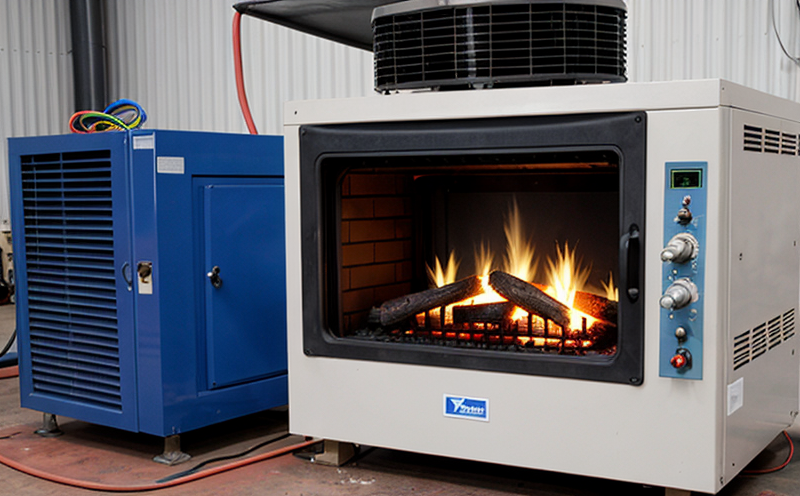ASTM C177 Thermal Conductivity Testing by Guarded Hot Plate Method
The ASTM C177 standard specifies a procedure to determine the thermal conductivity of rigid materials, such as those used in insulation and building products. This method uses the guarded hot plate technique, which is highly accurate for measuring the steady-state heat flow through a specimen placed between two plates with controlled temperatures.
The test setup consists of a heated upper plate, a lower insulated plate, and a specimen sandwiched between them. The temperature difference across the specimen is maintained using precision-controlled heaters and sensors. Heat flux meters measure the heat transfer rate, allowing for the calculation of thermal conductivity based on Fourier's Law:
q = -k * A * ΔT / d
This equation represents the relationship between heat flux (q), thermal conductivity (k), cross-sectional area (A), temperature difference (ΔT), and thickness (d) of the specimen. The guarded hot plate method is particularly useful for testing materials with small thicknesses, such as foams, gels, or thin films.
The ASTM C177 standard ensures consistency in the measurement process by providing detailed instructions on specimen preparation, thermal cycling, calibration procedures, and data analysis. Proper sample preparation includes ensuring uniformity of thickness, density, and composition to minimize errors due to internal variations within the material.
The guarded hot plate method is widely used across various sectors including construction, energy efficiency, insulation manufacturing, and HVAC systems. The test results are critical for validating product performance claims and ensuring compliance with building codes and standards like ASHRAE 90.1 or ISO 7324.
For accurate testing, it's essential to use high-precision equipment such as heat flux sensors, temperature controllers, and data loggers. The test setup should be capable of maintaining stable temperatures within tight tolerances (±0.5°C). Regular calibration against certified reference materials ensures reliable measurements throughout the lifetime of the instrument.
ASTM C177 is often employed in quality assurance programs where manufacturers need to demonstrate that their products meet specific thermal performance criteria set by regulatory bodies or industry associations.
Scope and Methodology
The ASTM C177 standard defines the procedure for determining the thermal conductivity of rigid materials using the guarded hot plate method. The scope includes:
- Determination of steady-state heat flow through a specimen placed between two plates.
- Measurement of temperature differences across the specimen and surrounding environment.
- Calculation of thermal conductivity based on Fourier's Law.
The methodology involves setting up the test apparatus, preparing the specimen according to specified dimensions and tolerances, applying heat to one side while maintaining the other in a controlled cold state. Continuous monitoring of temperature gradients ensures accurate data collection throughout the measurement period.
Calibration against known reference materials is crucial for obtaining precise results. After each calibration exercise, the test apparatus must undergo rigorous verification before conducting any commercial tests. This step helps maintain accuracy and traceability to international standards like ISO 7324.
The guarded hot plate method has several advantages over other thermal conductivity measurement techniques. It provides high precision due to its ability to control both heating and cooling conditions simultaneously. Additionally, it allows for direct contact between the specimen and the plates, reducing heat loss around the edges of the sample.
Customer Impact and Satisfaction
- Improved Product Quality: By adhering to ASTM C177 standards during manufacturing processes, companies can ensure consistent product quality. This leads to fewer returns, recalls, and customer complaints associated with substandard insulation materials.
- Enhanced Compliance: Many industries rely on ASTM C177 compliance as part of their regulatory requirements. Meeting these standards enhances reputation and reduces legal risks for businesses operating within regulated environments.
- Increased Market Share: Demonstrating adherence to recognized testing protocols like ASTM C177 can differentiate products in competitive markets, attracting more discerning customers who value reliability and safety.
- Better Consumer Trust: Consumers are increasingly aware of the importance of proper insulation when building or renovating homes. Companies that comply with ASTM C177 standards build trust among consumers by showing commitment to quality and environmental responsibility.
Regularly performing ASTM C177 tests helps manufacturers identify potential issues early on, allowing for timely adjustments in production processes. This proactive approach not only improves overall product performance but also contributes positively towards sustainable development goals.
International Acceptance and Recognition
- ISO 7324: ASTM C177 is harmonized with ISO 7324, which specifies the guarded hot plate method for thermal conductivity measurements. This international consensus standard ensures compatibility between different laboratories worldwide.
- ASHRAE Standards: The results from ASTM C177 tests are frequently used in compliance with ASHRAE standards such as ASHRAE 90.1, which sets energy efficiency requirements for buildings. Many jurisdictions adopt these guidelines into their local codes and regulations.
- Building Code Compliance: ASTM C177 plays a key role in ensuring that insulation materials used meet the thermal performance criteria outlined in various building codes around the globe. For example, in the United States, this standard is referenced by the International Energy Conservation Code (IECC).
The widespread acceptance of ASTM C177 extends beyond just North America; it's utilized globally across diverse industries including construction, HVAC, and refrigeration. Laboratories accredited to perform these tests according to ASTM C177 standards are recognized as authoritative sources for thermal conductivity data.
By ensuring strict adherence to this international standard, laboratories contribute significantly to the advancement of knowledge in materials science while simultaneously promoting sustainable practices within their respective sectors.





